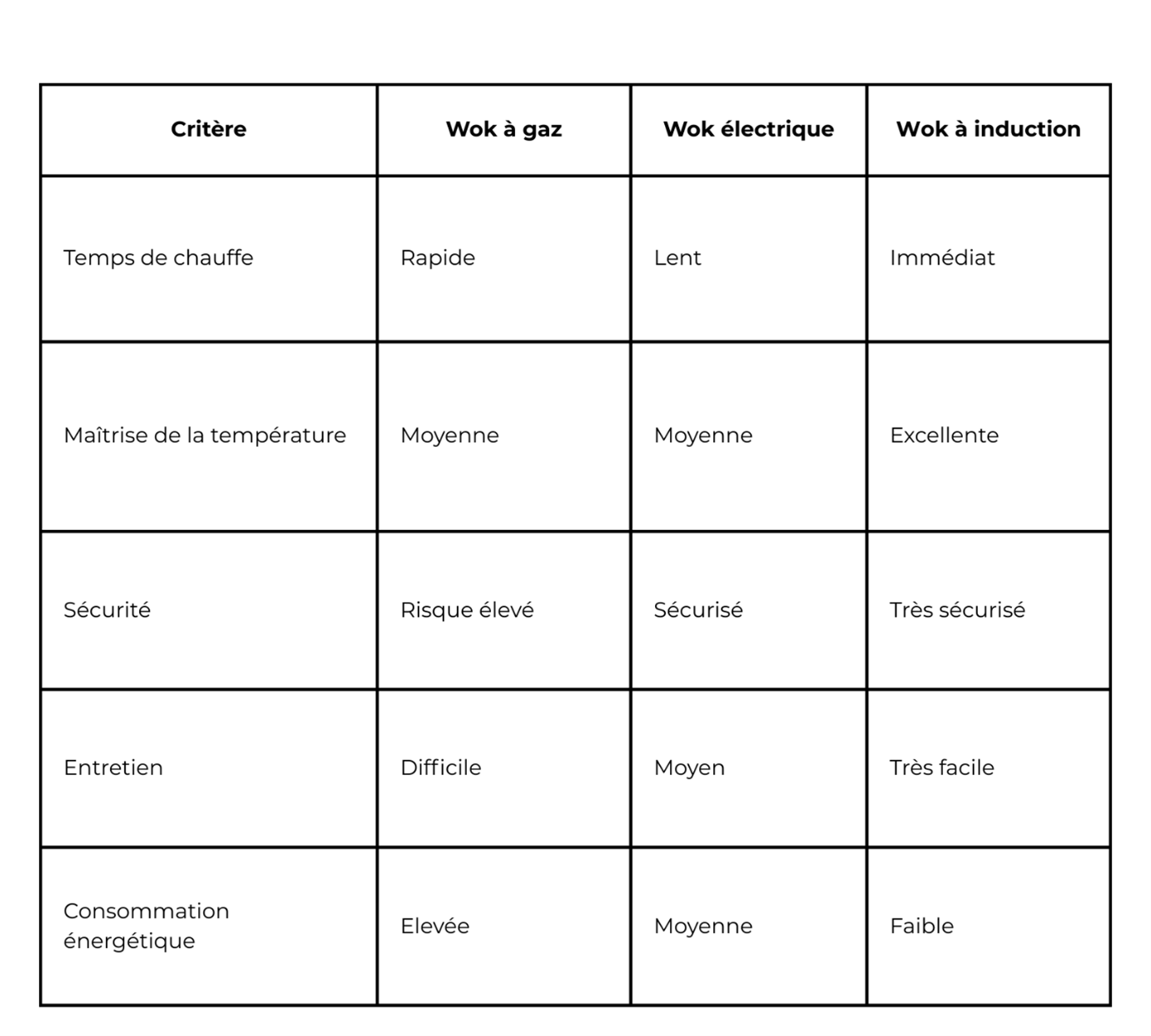Le wok à induction: avantages pour les cuisines professionnelles
Le wok à induction s’impose aujourd’hui comme une solution innovante pour les cuisines professionnelles. Offrant une cuisson rapide, homogène et économique, il devient un équipement incontournable pour les restaurateurs soucieux d'optimiser leur rendement et la qualité de leurs plats. Pourquoi adopter cette technologie et comment bien choisir son wok à induction ? Cet article vous apporte toutes les réponses.
Qu’est-ce qu’un wok à induction et comment fonctionne-t-il ?
Le wok à induction repose sur un champ électromagnétique qui chauffe directement le récipient, sans perte de chaleur. Contrairement aux woks traditionnels à gaz ou électriques, cette technologie permet une montée en température ultra-rapide et un contrôle précis de la cuisson.
Différences avec un wok traditionnel
- Wok à gaz : offre une puissance élevée, idéal pour des cuissons à feu vif mais la technologie gaz entraîne une déperdition de chaleur importante, présente des risques d’incendie, augmente drastiquement la chaleur ambiante et impose un nettoyage long et difficile.
- Wok électrique : le temps de chauffe est plus lent et manque de précision pour une utilisation professionnelle.
- Wok à induction : assure une chauffe instantanée, une sécurité optimale et une faible consommation d’énergie. Le nettoyage est rapide et la température ambiante reste stable
Pourquoi adopter un wok à induction en cuisine professionnelle ?
Rapidité et performance de cuisson
Le wok à induction est une technologie conçue pour offrir une cuisson ultra rapide et une maîtrise parfaite des températures. La chaleur est transmise directement dans le wok compatible, sans perte de chaleur, permettant une montée en température quasi instantanée et homogène.
Cette rapidité est un atout majeur en cuisine professionnelle, où chaque seconde compte pour assurer un service fluide et réactif. La puissance peut être facilement ajustée selon le type de préparation et les spécialités de l’établissement.
Économie d’énergie
Grâce à l’absence de perte thermique, la consommation d’énergie est optimisée, ce qui réduit les coûts énergétiques pour les restaurants. En comparaison avec un wok gaz, où une grande partie de ma chaleur s’échappe autour du récipient, l’induction convertit jusqu’à 90% de l’énergie utilisée en chaleur utile contre environ 40% seulement pour le gaz.
Moins d’énergie gaspillée signifie moins d’émissions de CO2, ce qui participe à une démarche plus écoresponsable.
Sécurité en cuisine
Une des raisons qui peut pousser un professionnel à choisir le wok à induction est la sécurité qu’il offre comparé aux autres types de cuisson. Un wok gaz utilise des flammes ouvertes, à l’inverse, l’induction n’en génère aucune. Cela réduit le risque d’incendie, particulièrement dans des établissement soumis à des températures élevées et à une utilisation intensive.
Aussi, la surface de l’équipement reste relativement froide atour de la zone de cuisson, ce qui réduit les risques de brulures accidentelles pour le personnel.
La technologie induction permet aussi d’avoir des dispositifs de sécurité intelligents qui peuvent couper l’appareil en cas de détecter de récipient vide ou en cas de surchauffe.
Facilité d’entretien
Le wok induction se distingue aussi par sa facilité d’entretien, un critère essentiel en cuisine professionnelle. Contrairement au wok à gaz qui peuvent accumuler des résidus et nécessiter plus d’entretien, les woks à induction sont très faciles à entretenir. Le bol en verre vitrocéramique est facilement nettoyable et l’absence de flamme élimine l’existence de résidus de combustions.
Confort de travail
Optez pour un wok à induction améliorera significativement le confort de travail en cuisine professionnelle, un aspect parfois sous-estimé pourtant crucial pour le bien-être des chefs et du personnel. La température dans la cuisine reste agréable, même dans des régions réputées pour des fortes chaleurs. L’absence de flame réduit aussi les fumées et les odeurs.
Enfin, la surface lisse et plane de l’induction facilite le déplacement des ustensiles et la manipulation des ingrédients, limitant les risques de brûlures ou d’accidents. En adoptant un wok à induction, les cuisines professionnelles gagnent en ergonomie, sécurité et efficacité, permettant aux équipes de travailler dans de meilleures conditions et d’optimiser leur productivité.

Quels critères pour bien choisir son wok à induction professionnel ?
Puissance et taille
Il est essentiel de choisir un modèle dont la puissance et le diamètre sont adaptés aux besoins de votre établissement. Choisissez une puissance élevée si vous recherchez de la réactivité et assurez vous de pouvoir ajuster le plus précisément possible la puissance.
Choix des matériaux
Optez pour un wok robuste avec une construction solide et durable. La cuisson wok est une cuisine « sportive », vous devez vous assurer de la haute résistance aux chocs.
Compatibilité des ustensiles
Attention aussi à choisir la bonne casserole wok, compatible induction et surtout à fond concave. Chez Adventys, nous avons fait le choix d’inclure dans le produit une casserole wok parfaitement compatible pour assurer des performances optimales.

En conclusion, le wok à induction s’impose comme un atout majeur dans les cuisines professionnelles. Alliant puissance, précision et rapidité, il permet de saisir les aliments à haute température tout en garantissant une cuisson homogène. Son efficacité énergétique, sa sécurité accrue et sa facilité d’entretien en font une alternative moderne aux woks traditionnels.
Que ce soit pour des restaurants asiatiques, des établissements de snacking ou des cuisines gastronomiques, investir dans un wok à induction, c’est faire le choix de la performance et de la fiabilité. Avec le bon équipement, les chefs peuvent exploiter tout le potentiel de la cuisine au wok, en associant tradition et innovation.
Partager ce contenu

